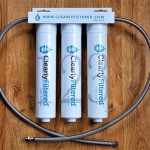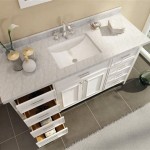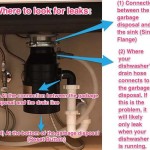Under Sink Reverse Osmosis (RO) System Reviews: A Comprehensive Guide
Reverse osmosis (RO) systems have become increasingly popular for filtering drinking water in residential settings. An under sink RO system offers a space-saving and effective solution to achieving cleaner, better-tasting water directly from the kitchen faucet. This article provides a comprehensive overview of under sink RO systems, highlighting key features, benefits, considerations, and reviewing several models to assist consumers in making informed purchasing decisions.
The purpose of an under sink RO system is to remove a wide range of contaminants from water, including sediment, chlorine, lead, arsenic, fluoride, and bacteria. These systems accomplish this using multiple stages of filtration, culminating in the reverse osmosis membrane, which is the core technology. The filtered water is then stored in a pressurized tank for on-demand access through a dedicated faucet, separate from the regular kitchen faucet. While the initial installation may require some plumbing knowledge, the long-term benefits often outweigh the setup effort.
Understanding the Mechanics of Reverse Osmosis
The reverse osmosis process involves forcing water under pressure through a semi-permeable membrane. This membrane has microscopic pores that allow water molecules to pass through while blocking larger molecules and contaminants. The water that passes through the membrane is purified water, while the contaminants are rejected and flushed down the drain. The efficiency of this process is determined by the membrane's quality, the water pressure, and the temperature of the water.
A typical under sink RO system consists of several stages: a sediment filter to remove particulate matter, a carbon filter to remove chlorine and other chemicals that affect taste and odor, the reverse osmosis membrane, and sometimes, a post-carbon filter to further polish the water before it reaches the faucet. Some advanced systems may also include remineralization stages to add beneficial minerals back into the water, which are often removed during the RO process.
Water pressure is a crucial factor for RO system performance. Most systems require a minimum water pressure of 40 PSI (pounds per square inch) to function effectively. If the water pressure is too low, the system may not produce enough purified water, or the water quality may be compromised. Booster pumps can be installed to increase water pressure if necessary.
Key Features to Consider When Choosing an Under Sink RO System
When selecting an under sink RO system, several key features should be carefully considered to ensure the system meets specific needs and preferences. These features include the filtration capacity, the number of filtration stages, the flow rate, the storage tank size, the filter replacement frequency, and the overall system efficiency.
Filtration capacity refers to the amount of water the system can purify per day, typically measured in gallons per day (GPD). This capacity should be sufficient to meet the household's daily water consumption needs. The number of filtration stages also impacts the system's effectiveness. More stages can mean more thorough filtration and removal of a wider range of contaminants.
The flow rate determines how quickly the system can dispense purified water. A higher flow rate is desirable for convenience, especially for households with multiple users. The storage tank size affects how much purified water is readily available. Larger tanks are beneficial for households that consume large quantities of water or prefer to have ample water on hand.
Filter replacement frequency is a crucial factor in maintaining the system's performance. Different filters have different lifespans, and regularly replacing them is essential for optimal water quality. Some systems have indicators that alert users when filters need to be replaced. The overall system efficiency, often measured by its recovery rate (ratio of purified water to wastewater), is a consideration for water conservation. Higher efficiency systems waste less water during the purification process.
Review of Popular Under Sink RO System Models
To provide a clearer understanding of available options, several popular under sink RO system models are reviewed below, highlighting their key features, pros, and cons.
APEC Water Systems ROES-50:
This is a widely recognized and reputable 5-stage RO system. It's known for its high-quality components and efficient filtration process. It effectively removes a broad spectrum of contaminants, including chlorine, lead, and fluoride. The system boasts a long filter lifespan, reducing the frequency of replacements. The APEC ROES-50 is also praised for its ease of installation and relatively quiet operation. However, its recovery rate could be improved compared to some newer models.iSpring RCC7:
The iSpring RCC7 is another popular 5-stage RO system that offers excellent water purification. It features a transparent first-stage housing, allowing users to visually monitor sediment buildup. The system is certified by NSF/ANSI standards, ensuring its performance and safety. The iSpring RCC7 is known for its competitive price point, making it an attractive option for budget-conscious consumers. However, some users have reported issues with the durability of certain components over extended use.Waterdrop G3 RO System:
The Waterdrop G3 is a tankless RO system, which eliminates the need for a storage tank and reduces space requirements. It utilizes a multi-stage filtration process, including a composite filter that combines several filtration layers. The Waterdrop G3 is known for its fast flow rate and intelligent monitoring system, which provides real-time water quality information. The tankless design also minimizes the risk of bacterial contamination. However, tankless systems tend to be more expensive than traditional tank-based systems.Home Master TMAFC Artesian Full Contact:
This system distinguishes itself by adding minerals back into the purified water, enhancing its taste and nutritional value. The Home Master TMAFC Artesian features a 7-stage filtration process, including a remineralization stage that adds calcium and magnesium. It also has a larger tubing size, which improves the flow rate. The Home Master TMAFC Artesian is a suitable choice for individuals who prefer mineral-rich drinking water. However, the remineralization process may slightly reduce the overall purification efficiency.Express Water ROALK5D:
The Express Water ROALK5D is a 5-stage system that also incorporates an alkaline remineralization filter, boosting the pH of the water. It claims to remove up to 99.99% of major contaminants and is designed for ease of installation. Many users praise the clear instructions and included components, making the DIY setup process smoother. However, similar to other remineralization systems, the addition of minerals could necessitate more frequent filter changes depending on the source water quality.These reviewed models represent a range of options, each with its unique strengths and trade-offs. The optimal choice will depend on specific needs, budget, and water quality concerns. Consumers should carefully assess their requirements and compare the features and performance of different models before making a purchase.
Installation and Maintenance Considerations
The installation of an under sink RO system typically involves connecting the system to the cold water line under the sink, installing a dedicated faucet, and connecting a drain line for wastewater disposal. While some individuals may be comfortable performing the installation themselves, others may prefer to hire a professional plumber to ensure proper setup and prevent leaks. Thoroughly reading and understanding the manufacturer's instructions is essential, regardless of who performs the installation.
Regular maintenance is crucial for preserving the system's performance and longevity. This includes replacing the filters according to the manufacturer's recommendations and periodically sanitizing the storage tank. Filter replacement frequency varies depending on the filter type and water quality but is generally recommended every 6 to 12 months for pre-filters and post-filters, and every 2 to 5 years for the RO membrane. To sanitize the tank, close the inlet supply valve, drain the tank, and introduce a diluted bleach solution. Allow the solution to sit for a specified period, then thoroughly flush the system with fresh water.
Troubleshooting common issues, such as leaks, slow flow rates, or unusual tastes in the water, is also part of maintenance. Leaks can often be resolved by tightening connections or replacing worn O-rings. Slow flow rates may indicate a clogged filter or low water pressure. Unusual tastes may indicate a need for filter replacement or sanitization. Consulting the manufacturer's documentation or contacting customer support can provide guidance for addressing these issues.
Proper installation and meticulous maintenance extend the system's life and ensure continual access to pristine drinking water. Ignoring these critical elements can lead to a decrease in performance, potential water damage, and increased running costs.

Reviews For Apec Water Systems Ultimate Premium Quality 90 Gpd Ph Alkaline Mineral Under Sink Reverse Osmosis Drinking Filter System Pg 2 The Home

7 Best Reverse Osmosis Systems Of 2024

Aquatru Review My Honest Thoughts Coconuts Kettlebells

Reviews For Apec Water Systems Essence Series Top Tier 5 Stage Under Sink Reverse Osmosis Filtration System Extra Replacement Pre Filter Set Pg 1 The Home

Reviews For Ispring Maximum Performance Under Sink Reverse Osmosis Water Filtration System With Booster Pump And Alkaline Filter Pg 2 The Home

The Best Under Sink Water Filter For 2025 Reviews By Wirecutter

Review Whirlpool Wher25 Ro System Tralfaz

Reviews For Waterdrop Tankless 3 Stage Under Sink Reverse Osmosis Water Filtration System With 800 Gpd Membrane And Uv Sterilizer Pg 1 The Home

Whole House Vs Under Sink Filters

Pdp Standard Description Template







